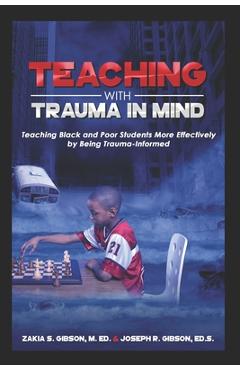Teaching With Trauma in Mind: Teaching Black and Poor Students More Effectively by Being Trauma-Informed - Zakia S. Gibson

Detalii Teaching With Trauma in Mind:
libris.ro
123.94 Lei
154.92 Lei
Education
Zakia S. Gibson
Teaching With Trauma in Mind: - Disponibil la libris.ro
Pe YEO găsești Teaching With Trauma in Mind: de la Zakia S. Gibson, în categoria Education.
Indiferent de nevoile tale, Teaching With Trauma in Mind: Teaching Black and Poor Students More Effectively by Being Trauma-Informed - Zakia S. Gibson din categoria Education îți poate aduce un echilibru perfect între calitate și preț, cu avantaje practice și moderne.
Preț: 123.94 Lei
Caracteristicile produsului Teaching With Trauma in Mind:
Comandă Teaching With Trauma in Mind: Online, Simplu și Rapid
Prin intermediul platformei YEO, poți comanda Teaching With Trauma in Mind: de la libris.ro rapid și în siguranță. Bucură-te de o experiență de cumpărături online optimizată și descoperă cele mai bune oferte actualizate constant.
Descriere magazin:
Please check out more of our related titles at thepgi.org About five years ago, the National Task Force on Children Exposed to Violence recommended (or perhaps more accurately, warned) that every school in our country should have trauma-informed staff and consultants providing school-based trauma-specific treatment. Apparently, few schools-especially those with high-poverty, high-minority student populations-actually heard (and heeded) the recommendation. Most teachers and administrators have accepted that there is simply not enough time to focus on soft skills like teaching impulse control, resilience, or emotional regulation and concurrently cover enough content to get test scores high enough to maintain their employment. Our rebuttal to this conclusion is that time isn\'t their problem, values and priorities are. In other words, if being a trauma-informed educator was adequately valued, then it would be prioritized and time would be found to be a trauma-informed educator. Becoming trauma-informed also requires a fundamental understanding that trauma, to quote Catherine Woodiwiss, permanently changes us. Specifically, the chronic stress accompanying ongoing (or complex) childhood trauma can negatively and enduringly change a child\'s brain. Childhood traumas like physical or emotional abuse, sexual assault, and persistent family poverty typically triggers neuroplasticity.The commonness of students in classrooms across this country experiencing trauma and trauma-based maladaptive neuroplasticity is far greater than most of us would ever comfortably imagine. Most studies have concluded that 25-40% of all students have already been exposed to (and their brains changed by) some type of acute or complex childhood trauma. Considering the traumatic impact of race and poverty, instead of 25-40%, in these schools we\'re possibly looking at closer to 80-90% of students presumably having already been exposed to (and their brains negatively changed by) childhood trauma.Race and poverty are highly prevalent traumatic stressors-logically-in schools that have higher percentages of Black and poor students. However, because race and poverty are not typically recognized by educators as traumatic stressors, trauma is not looked at as the most likely motivation for the common negative student behaviors experienced in such schools. Moreover, becoming more trauma-informed is not particularly valued by educators in schools that have higher percentages of Black and poo

Produse asemănătoare

The Trauma-Sensitive Classroom: Building Resilience with Compassionate Teaching, Paperback/Patricia A. Jennings
![]() elefant.ro
elefant.ro
Actualizat in 21/12/2024
239.99 Lei

Teaching With Trauma in Mind: Teaching Black and Poor Students More Effectively by Being Trauma-Informed - Zakia S. Gibson
![]() libris.ro
libris.ro
Actualizat in 15/12/2024
123.94 Lei

The A-Z of Trauma-Informed Teaching: Strategies and Solutions to Help with Behaviour and Support for Children Aged 3-11 - Sarah Naish
![]() libris.ro
libris.ro
Actualizat in 15/12/2024
215.39 Lei
Produse marca Zakia S. Gibson

Teaching With Trauma in Mind: Teaching Black and Poor Students More Effectively by Being Trauma-Informed - Zakia S. Gibson
![]() libris.ro
libris.ro
Actualizat in 15/12/2024
123.94 Lei
